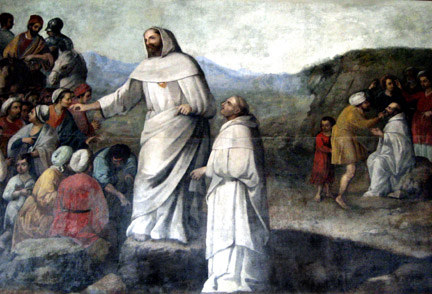
Not to be confused with St. Raymond of Pennafort, the cofounder of the Order of Mercy, St. Raymond Nonnatus, one of the most illustrious members of that Order, deserves the title Champion of Catholic Orthodoxy for his having ransomed so many Christians from the danger of apostasy, for having exhorted so many others to perseverance in their Holy Faith, and for having converted or confounded many of their Muslim captors. Born in Catalonia in 1204, he is called Nonnatus ("not born") because he was delivered by Caesarian section after his mother's death. He was devoted to piety and study from his earliest years. His father, who wished to cross his inclination to the religious state, took him out of school and sent him to tend to a farm which he had in the country. Raymond readily obeyed, and took advantage of the exile to live the life of a hermit, tending to the sheep himself and spending much time in prayer and meditation in the forests and mountains.
At last, through the mediation of the Count of Cardona, Raymond obtained leave of his father to enter the Order of Mercy. He was admitted to his profession at Barcelona by the holy founder himself, St. Peter Nolasco. So surprising was the progress that he made in the perfection of his holy institute, that, within 2 or 3 years after his profession, he was judged the best qualified to discharge the office of Ransomer, in which he succeeded St. Peter.
Being sent into Barbary with a considerable sum of money, he purchased at Algiers the liberty of a great number of slaves. When all this treasure was spent in that charitable way, he voluntarily gave himself up as a hostage for the ransom of certain others, whose situation was hardest, and whose faith seemed exposed to imminent danger. This sacrifice of himself only exasperated the Muslims, who treated him with uncommon barbarity. Later, fearing lest if he die in their hands they should lose the ransom to be paid for the slaves for whom he remained hostage, the magistrate of the city gave orders that he should be treated more humanely. Hereupon he was permitted to go abroad in the streets; which liberty he made use of to comfort and encourage the Christians in their chains, and he converted and baptized some Muslims. The latter being a capital offense, the governor ordered him to be impaled; but this sentence of death was also commuted for fear of losing ransom money. He did endure a cruel bastinado (a punishment consisting of being beaten with a stick, usually on the soles of the feet), yet so long as he saw souls in danger of perishing eternally, he thought he had yet done nothing; nor could he let slip away any opportunity of endeavoring to prevent so frightful a misfortune.
He therefore, resumed his former method of instructing and exhorting both the Christians and the infidels. The governor, who was immediately informed of his behavior, commanded the servant of Christ to be whipped at the corners of all the streets of the city, his lips to be bored with a red-hot iron in the marketplace, and his mouth shut up with a padlock, the key of which he kept himself, and only gave to the guards when the prisoner was allowed to eat. In this condition he was loaded with iron bolts and chains, and cast into a dark dungeon, where he lay for eight full months, until his ransom was bought by some Religious of his Order, who were sent with it by St. Peter Nolasco. Only obedience to his superior could convince Raymond to leave his dungeon and the country of his zealous endeavors, and he begged God to accept his tears, humbly believing he was not worthy to shed his blood for the souls of his neighbors.
Upon his return to Spain he was nominated Cardinal by Pope Gregory IX. But so little was he affected with the involuntary honor, that he neither changed his dress, nor his poor cell in the convent, nor his manner of living. The Pope, being desirous to have so holy a man about his person, and to employ him in the public affairs of the Church, called him to Rome. The Saint obeyed, but could not be persuaded to travel otherwise than as a poor Religious. He got no further than Cardona, which is only 6 miles from Barcelona, when he was seized with a violent fever, which soon became mortal. St. Raymond prepared himself for his last passage. Some historians relate that he was favored with a vision of Angels, in which he received the Holy Viaticum. He died on August 31, in the year 1240, at the age of 37. He was buried in a chapel of St. Nicholas, near the farm in which he formerly lived. St. Peter Nolasco founded a great convent in that place in 1255, and St. Raymond's relics are still kept in that church - the site of many miracles wrought by him. Pope Alexander VII inserted his name in the Martyrology in 1657.
Contact us: smr@salvemariaregina.info
Visit also: www.marienfried.com